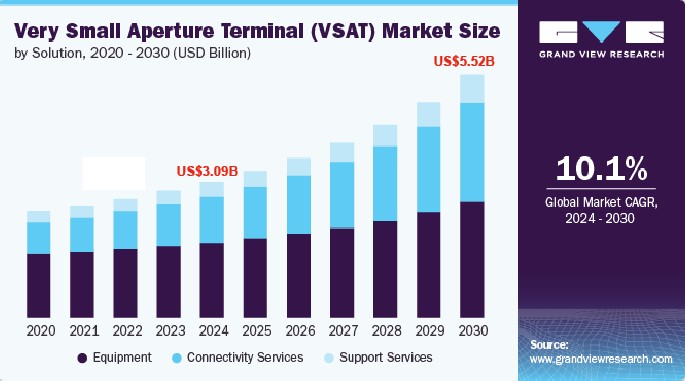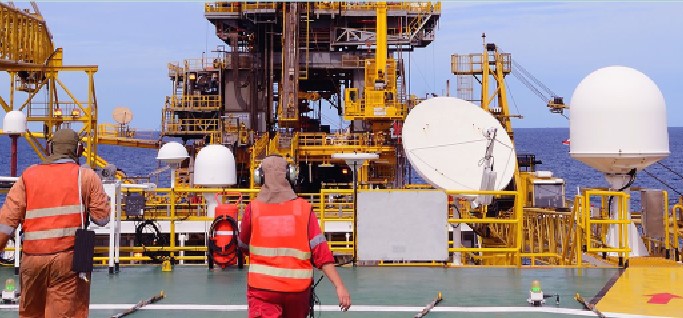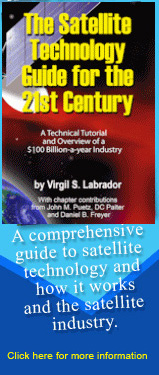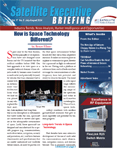The VSAT Market
By Elisabeth Tweedie
Los Angeles, Calif., May 7, 2025 - According to Novaspace, in 2022 there were 5.6 million commercial Very Small Aperture Terminals (VSATs) in use around the world. Novaspace is forecasting a 2.3x growth rate in this number to 2032, meaning there will be 12.88 million commercial VSATs in use that year. It is also forecasting a cumulative market value for the entire ground system (i.e. not just VSATs) of US$ 80 billion between 2023 and 2032. As technology onboard satellites advances providing greater and greater throughputs, so ground technology has advanced and improved in order to handle far greater speeds and capacities. IPStar launched in 2005, is generally considered to be the first high throughput satellite, its capacity was 45 gigabits per second (Gbps).
Viasat 3’s designed capacity is 1 terabit per second (Tbps). Adding to the challenge for the ground systems, many of the latest satellites are software defined, meaning that capacity can be switched between different beams as needed. Indeed, without these advances on the ground, the advances in space would have been useless.
Initially VSATs were seen as a way of extending terrestrial networks to rural areas lacking good connectivity and this is still the case in some segments, notably cellular backhaul. There are however, many VSAT installations in areas well served by terrestrial infrastructure. Some of these are used as backup solutions, but for others, gas stations and retailers for example, VSATs remain the primary way of linking hundreds or thousands of outlets. Essentially VSATs are an ideal way of connecting distributed locations in all sectors, public, private and military.
 |
VSAT Terminals
From the original design of a small, fixed parabolic antenna, several different terminal types now fall under the generic label of VSAT. These include:
- A fixed parabolic antenna, much like the original.
- A fixed flyaway antenna. These are modular and lightweight, so they can be disassembled, and packed up, in order to be transported to wherever there is a temporary need for satellite communication. They are often used for disasters or major breaking news stories. If the antenna is under one meter in diameter, as some of them are, they can be packed in a suitcase small enough to travel in hand luggage on a flight.
- A mobile antenna, mounted on a vehicle. These are often used for satellite news gathering (SNG), although in many places they have now been replaced by bonded cellular.
- A mobile parabolic antenna. These are generally used in the maritime and aeronautical markets. This antenna is mounted on a pedestal with a motor to orient the dish and track the satellite, as well as compensate for any disturbances, e.g. rough seas or turbulence in the air.
- Gimbal Antennas, these are for the aero market. The gimbal on which the antenna is mounted, enables the antenna to rotate around one unique axis.
- Flat panel antennas (FPAs), these are recent additions to the VSAT family. They were primarily developed as an alternative to tracking antennas for the Low Earth Orbit (LEO) market. Unlike parabolic antennas, these work best when facing straight up and can track more than one satellite at a time. Beam pointing is controlled electronically.
Key Markets Government and Military
As well as being used to link government offices, VSATs are also used for a number of specialist applications. These include, education, telemedicine, disaster response and defense.
- Education, in many countries, particularly in developing regions many of the schools are situated in the more remote regions. Satellite technology is an ideal way to connect them. Connectivity provides internet access and communication with other schools and the world in general, and also to provides distance learning lessons, which can be delivered by better qualified teachers than may be available locally. But it’s not only in developing regions that VSATs are used for distance learning. In the US, many Native American lands remain remote and disconnected from broadband terrestrial infrastructure, and also, due to the remote locations, from good teachers. VSATS are used to link these communities with each other and provide better education than would otherwise be available.
- Telemedicine, lack of access to healthcare and medical services in rural and remote regions is a major issue in many countries. VSATs provide crucial communications between remote specialists and local medical staff engaged in on-the-ground healthcare. With the advent of high-speed connectivity, test results, diagnostic images and videos can be transmitted enabling rapid diagnosis and assistance. This was particularly important during the Covid crisis when temporary hospitals were built and needed rapid connectivity.
- Disaster Response, when earthquakes, hurricanes, fires and floods strike, all too often communications on the ground are destroyed or crippled. Rapid VSAT installations which can be used to set up local WiFi hotspots, enable first responders and Non-Governmental Organizations ( NGOs) to communicate with each other and the outside world, facilitating relief efforts. Those Wifi hotspots, can also be used by residents impacted by the disaster, to communicate with concerned family and friends.
- Defense, not only can VSATs be used to connect remote field offices, they are invaluable for troops on the ground, enabling transmission of information from earth observation satellites showing enemy movements. But it’s not only on the ground that VSATs are used. Tech Insights forecasts that global military VSAT expenditure will approach US$ 1.9 billion by 2031, a ten-year CAGR of 3.8%. Combat aircraft will be the largest segment in military VSAT expenditure. This growth is fueled by increasing bandwidth demand amid increasing air to air and air to ground network connectivity and uptake of software-defined digital and solid-state technologies.
Cellular Backhaul
Satellite cellular backhaul has long been used by mobile network operators (MNOs) to expand their network coverage to areas not well served by terrestrial broadband networks. Use of satellite for backhaul comes with several advantages for the MNO:
- It enables rapid expansion, as a VSAT can be installed quickly with no dependence on other infrastructure being in place.
- It is cost effective, when compared to laying new fiber.
- It is often the only realistic way to backhaul traffic in remote and difficult terrains, such as mountainous regions or islands. In these locations, not only would the cost of extending a terrestrial infrastructure be prohibitive, the time to lay new fiber would cause excessive delays to the MNOs plans.
- Satellite backhaul has proved itself as the solution for 2G, 3G and 4G networks, and now it is also being used for 5G. As the rollout of 5G continues at a rapid pace, so too will the demand for satellite backhaul. Analysys Mason forecasts that the satellite backhaul market will generate US$ 30.9 billion cumulatively during the period 2022-2032 and wholesale capacity revenues will increase at a CAGR of 12.1%. Key drivers of this growth are the continued expansion of 4G networks and the rapidly increasing numbers of the small cell sites, needed for 5G.
However, this market is far from static. Traditionally the purview of geostationary satellite (GEO) operators, the new low-earth orbit (LEO) operators are challenging GEO’s dominance. Analysys Mason is forecasting that non-GEO cellular backhaul solutions will generate more than US$ 2 billion in 2033 increasing the non-GEO market share of cellular backhaul from 5% in 2023 to 44% in 2033. An African mobile operator was the first Mobile Network Operator (MNO) to use one of the LEO backhaul services. It deployed its first LEO base station for backhaul in Nigeria in April 2024 and by September of that year had installed over 100 LEO base stations and has plans to at least double that number. LEOs are able to provide lower latency and greater bandwidth compared to a GEO satellite. As would be expected this is of great benefit to the MNO, which reported that traffic has increased by 45% at sites equipped with the LEO base station.
Enterprise
VSATs are used in a wide variety of commercial enterprises including retail, banking and finance.
- Banking and Finance, many large banks depend on VSATs to support ATM machines and as backup to wired networks. One of the largest VSAT networks in the world, is that of the National Stock Exchange in India, VSATs enable transactions in locations where wired options are limited or non-existent.
- Retail and Gas (Petrol) Stations, Walmart may have been the first, but today many retailers, restaurants and gas stations are dependent on VSATs. Today, these networks carry tens of millions of credit card transactions daily. They also enable in-store ATMs and prescription systems for pharmacies.
Energy
Almost by definition, the majority of oil and gas exploration and extraction takes place in remote and offshore locations, where VSATs are the only possible means of communication. There are multiple uses for VSATS on oil and gas rigs: during the exploration phase copious amounts of data is generated and needs to be transmitted back to shore; once a rig is fully in service, there is operational data to be transmitted, not only from the staff, but also from the equipment itself, as Internet of Things (IoT) sensors are used to monitor equipment. In addition, crew members will be stationed on rigs for many weeks at a time, and have come to expect the same level of connectivity that they have at home, so high bandwidth is needed for gaming, video streaming and video calling.
Pipelines travel vast distances, usually across uninhabited regions, necessitating remote monitoring of sensors to check for leaks, so again VSATs are needed to transmit the information. Nowadays, not only are there sensors on the pipelines, there may also be autonomous or remotely operated equipment that can be sent to the site of a leak to make the necessary repairs.
Maritime and Aeronautical
|
(Image courtesy of vector InfoTech) |
By definition these two segments have to rely on satellites for connectivity. For maritime, key uses include navigation, operations, cargo monitoring, communications, safety and crew welfare. Even more so than crews stationed on offshore rigs, crews on naval and commercial shipping vessels spend a great deal of time at sea, usually many months. So, provision of broadband internet is becoming a necessity. In fact mandatory social connectivity, including internet access was written into the Maritime Labor Convention in 2022. In 2024, the Sailor’s Society published its “State of the Industry Report,” this clearly demonstrated just how important, internet access is for crew, showing that overall wellbeing increased in line with quality internet access.
Even more demanding than crew members, passengers on cruise lines expect to be able to share their photos and videos with friends back home, as well as use their normal streaming services. Taking a cruise is no longer seen as an opportunity to “get away from it all,” rather it is seen as an opportunity to spend even more time connected than they’re able to do when at home and constrained by the demands of a job. This has led to a huge surge in demand for broadband connectivity. GMI forecasts that the maritime connectivity market will grow from US$5.9 billion in 2022 to US$12.4 billion in 2032, a CAGR of 8.5%. VSATs will account for over 55% of that market. Satellite services will account for the rest.
The in-flight connectivity market is also being driven by passengers expectations of high-speed broadband, so that they can stream movies and essentially use their devices in exactly the same way that they do on land.
VSAT Networks Topology
A VSAT network will fall into one of two configurations; it will either be a Star or a Mesh network.
The star topology is a simple design with every terminal connecting into a central hub. This allows for easy deployment and network expansion. It is also potentially more secure as the central hub facilitates monitoring, control and security. The star topology remains the most cost-effective network and has a long track record of reliability. The main disadvantage of a star network is that if the hub goes down, so does the entire network.
In a mesh topology, there are multiple paths for data transmission as each terminal is connected to at least two other terminals, ensuring built-in redundancy so increasing reliability. The disadvantage is that the network can be complex to manage and the equipment can be more expensive.
Managed Network Services
The days of customers buying MHz are largely in the rear view mirror. As options increase: GEO, MEO, LEO, fiber, 5G; networks become more complex. At the same time expectations increase and customers’ become more demanding, expecting high Committed Information Rates (CIRs) and Service Level Agreements (SLAs). As a result, very few teleport operators still sell bandwidth, they provide Managed Network Services (MNS). A MNS will design the optimum network for each customer, install it and also operate and maintain it. The complexity of the transmission path has grown exponentially in the last ten years and is likely to continue to do so, so it becomes essential for operators to provide a value-added, end-to-end, turnkey solution. Teleport operators are no longer satellite providers, they have become connectivity providers, as their customers become less interested in the transmission path and more interested in quality, reliability and economics.
This presents challenges for the Operators as it becomes essential for them to have a very different workforce than that of ten years ago. Staff must now understand multiple technologies (IP as well as RF), complex transmission paths and complicated handovers between different satellites, orbits, frequencies and terrestrial networks. Handovers that are frequently complicated by the VSAT itself being on the move.
Es’hailSat
Given the complexities of today’s networks, it is important to choose wisely when looking for an operator or service provider for VSAT network services. Headquartered in Doha, Qatar, Es’hailSat is major operator in the Middle East, and through strategic alliances with other operators is on the way to fulfilling its vision of becoming a global satellite operator.
Es’hailSat is focused on embracing all modern advancements in the industry and deploying state-of-the-art technology. It partners and collaborates with a variety of technology innovators to ensure that its equipment, like the facilities, are the best in class. Current equipment includes an ST Engineering iDirect hub, optical ground stations and flat panel antennas (FPAs) from Kymeta. There are also multiple diverse fiber connections into the teleport, providing redundant connectivity to the global internet backbone.
Its 50,000 square meter teleport located in Al Ghuwariyah on the outskirts of Doha in the north of Qatar has recently been awarded Tier 4 certification from the World Teleport Association (WTA). Certification is issued after a thorough audit of the teleport by a WTA auditor to validate that the teleport meets standards developed by the WTA Certification Committee. WTA certification is issued at tiers 1 through 4, with Tier 4 representing the highest degree of excellence. On receipt of the award Mr. Ali Al Kuwari, President and CEO, Es’hailSat, commented, “Es’hailSat is proud to achieve Tier 4 certification of our state-of-the-art Teleport facility in Doha. It underscores the high quality of service that we have been providing our customers from across the Middle East and North Africa region, be it on the broadcasting side or from our data connectivity portfolio. It also is a testament to the efforts put in by the entire team in achieving this prestigious certification, for which we are truly delighted.”
In addition, the Occupational Health and Safety Management System of the teleport has been awarded ISO 45001:2018 certification covering hosting, broadcasting, VSAT, transmission and satellite telecommunication services.
As would be expected from an organization that prides itself on offering the latest and best technology, its support staff are young, multi-lingual engineers, well trained and certified in installation, support and maintenance.
Es’hailSat may be better known for its broadcast and media services, but it also has a strong presence in the VSAT market, with a particular focus on serving the cellular backhaul and government sectors.
The managed VSAT service, uses top-of-the line equipment, connecting to its two co-located satellites, operating in Ku and Ka-band, covering the Middle East and North Africa. As well as providing 24/7 support, Es’hailSat’s managed VSAT service is completely flexible, tailored to the needs of each customer and providing the flexibility to upgrade and/or change requirements. The VSAT network can easily be integrated with other telecoms networks, 5G and fiber for example.
Clients of the managed VSAT service are not limited to using Es’hailSat’s satellites. The company has a strategic alliance with Nilesat and also has a hybrid solution that combines GEO and LEO connectivity providing seamless transition between the two satellite systems and cellular networks. As discussed in the Executive Spotlight and Case Study, Es’hailSat is providing a mobile VSAT network for a government customer, integrating
LEO and GEO satellite coverage with cellular networks to provide reliable communications in diverse environments. This application uses a flat panel antenna (FPA) so as not to impact the aerodynamics of the vehicle.
Es’hailSat’s cellular backhaul service is available across the MENA region and customers include Ooredoo and Vodafone.
In addition to its impressive achievements, Es’hailSat has demonstrated its capability to offer global coverage through strategic partnerships with renowned satellite operators around the world. These collaborations have enabled Es’hailSat to extend its services beyond the Middle East and North Africa region, ensuring global reach and connectivity.
If you’re looking for a partner for your VSAT service in the MENA region, Es’hailSat’s outstanding facilities and skilled workforce, provide everything that you will need, including the option for geographical expansion around the world.
-----------------------------
 Elisabeth Tweedie is Associate Editor of the Satellite Executive Briefing. She has over 20 years experience at the cutting edge of new communications entertainment technologies. She is the founder and President of Definitive Direction (www.definitivedirection.com), a consultancy that focuses on researching and evaluating the long-term potential for new ventures, initiating their development, and identifying and developing appropriate alliances. She can be reached at: etweedie@definitivedirection.com
Elisabeth Tweedie is Associate Editor of the Satellite Executive Briefing. She has over 20 years experience at the cutting edge of new communications entertainment technologies. She is the founder and President of Definitive Direction (www.definitivedirection.com), a consultancy that focuses on researching and evaluating the long-term potential for new ventures, initiating their development, and identifying and developing appropriate alliances. She can be reached at: etweedie@definitivedirection.com






